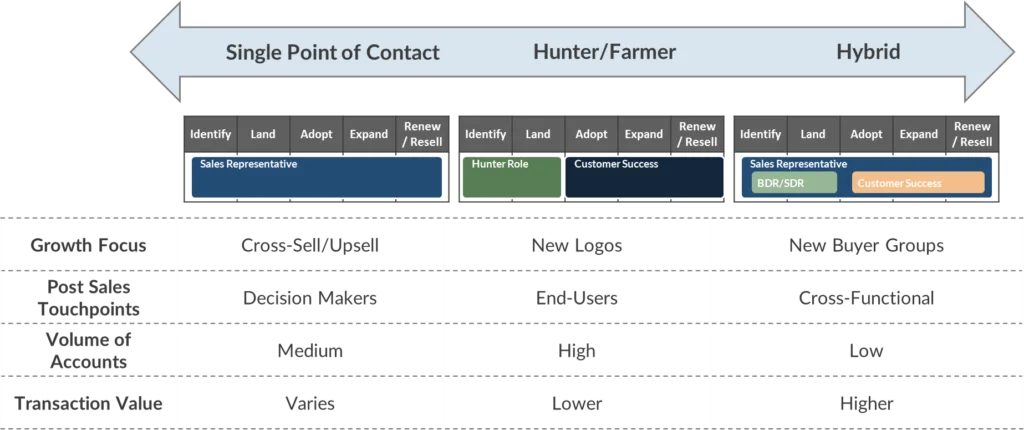In the dynamic landscape of B2B sales and marketing, the concept of coverage design stands as a strategic linchpin, weaving together the threads of revenue generation, customer experience, and cost-effectiveness.
Coverage Design—What Is It?
Coverage design is a strategic approach to revenue generation. It involves outlining the specific channels and roles that will execute each task in the customer journey. This systematic organization of revenue motions, termed a ‘coverage model’, is key to providing a top-tier customer experience while ensuring cost-effectiveness, typically measured as the Expense-to-Revenue (E/R) ratio.
Coverage models map essential customer touchpoints to the resources required to service them. This includes both strategic and tactical levels of interaction. At the strategic level, channel models align with market segments, whereas, at the tactical level, coverage extends inside accounts and across the sales pipeline.
Two Coverage Design Types: Tactical and Strategic
There are two levels of coverage design typically approached in business operations: 1) Strategic Coverage Design and 2) Tactical Coverage Design.
1. Strategic Coverage Design
Strategic coverage design involves long-term decisions about the selection of channels used to engage targeted markets. At the highest level, this means choosing between direct and indirect coverage.
- Direct coverage leverages a company’s internal resources (say internal sales) to drive revenue. It gives more control over the customer relationship, which, over time, is a considerable advantage, especially in owning customer data.
- Indirect coverage, on the other hand, involves outsourcing go-to-market activities to an agent. Indirect coverage, often referred to as “the channel” in B2B tech go-to-market strategies, is attractive for several reasons. It can be quickly activated, offers full-funnel solutions, and can bundle your product with other complementary products, creating a more attractive value proposition. However, it comes with a literal cost, the channel discount or commission.

Channel (indirect) vs. Direct economics. The channel discount–13 cents per dollar in this example—essentially pays for go-to-market other than brand advertising.
Therefore, strategic coverage design involves deciding which route-to-market to choose for a given product-focus segment intersection.
2. Tactical Coverage Design
Tactical coverage design takes a deep dive into the learn-shop-buy process to map each interaction from the customer’s perspective. There are three primary models of tactical coverage in use today:
- Single Point of Contact approach: One resource handles the entirety of the sales process, from prospecting to closing, and ensuring post-sales customer success.
- Hunter-Farmer approach: This model bifurcates the sales team into acquisition-focused and retention/success-focused resources.
- Hybrid approach: This approach is the most specialized, dividing tasks into lead generation, sales, and account management roles.

Designing an optimal tactical coverage model is a balance of three interrelated factors: customer-channel preference, seller and role capability, and economic efficiency. By considering these factors, businesses can ensure that all customer touchpoints are covered and the appropriate resources are allocated to each stage of the sales process.
The Power of Coverage Design in Optimizing Business Performance
To summarize, coverage models play a pivotal role in enabling organizations to drive profitable revenue growth while providing a superior customer experience. Strategic and tactical coverage designs form the backbone of these models, with strategic coverage choosing the ideal channels for market engagement, and tactical coverage optimizing the allocation of resources across the customer journey.
By striking a balance between channel preferences, role capabilities, and economic efficiency, an optimized coverage model can be developed, leading to enhanced organizational performance and customer satisfaction.
For a more comprehensive understanding of designing optimal B2B go-to-market strategies, download our whitepaper “A Roadmap for Modern B2B Go-to-Market—Part 1: Growth Design.” This guide offers detailed insights and practical tips to help you streamline your go-to-market operations and achieve your business objectives.

Download our whitepaper, “A Roadmap for Modern B2B Go-to-Market: Part 1 – Growth Design”
Learn what it takes to find and maintain predictable revenue growth in our essential 49-page whitepaper.



